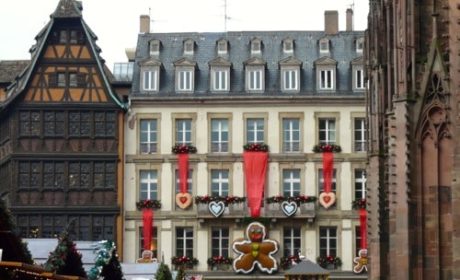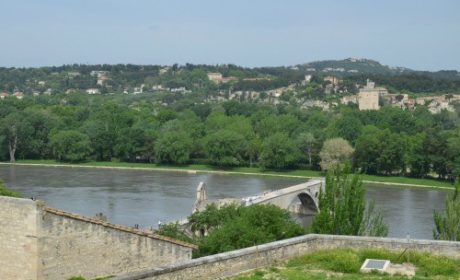If you’re looking for tips on what to see in Versailles, you’ve come to the right article. Through the years, My Itchy Travel Feet has published some excellent tips on visiting France, including my favorite, a Burgundy Canal Barge Cruise.
My Itchy Travel Feet featured writer, Debi Lander of ByLanderSea, writes often about French travel. I especially enjoyed her article on how to plan a Champagne Country Road Trip. She’s back with tips on what to see in Versailles. Debi says it’s an easy day trip from Paris.
Louis XIV built Versailles to impress visitors, and indeed it does, often called the grandest of all royal palaces. The estate became the symbol of the monarchy, the seat of power, and the passion of the French King.
Many first-time visitors to Paris wisely plan a day trip to visit the Versailles Palace and Gardens. The extraordinary and immense UNESCO World Heritage site lies 14 miles outside the city. Expect crowds in the Palace and more gold leaf than you’ve ever seen before.
Table of Contents
History of Versailles
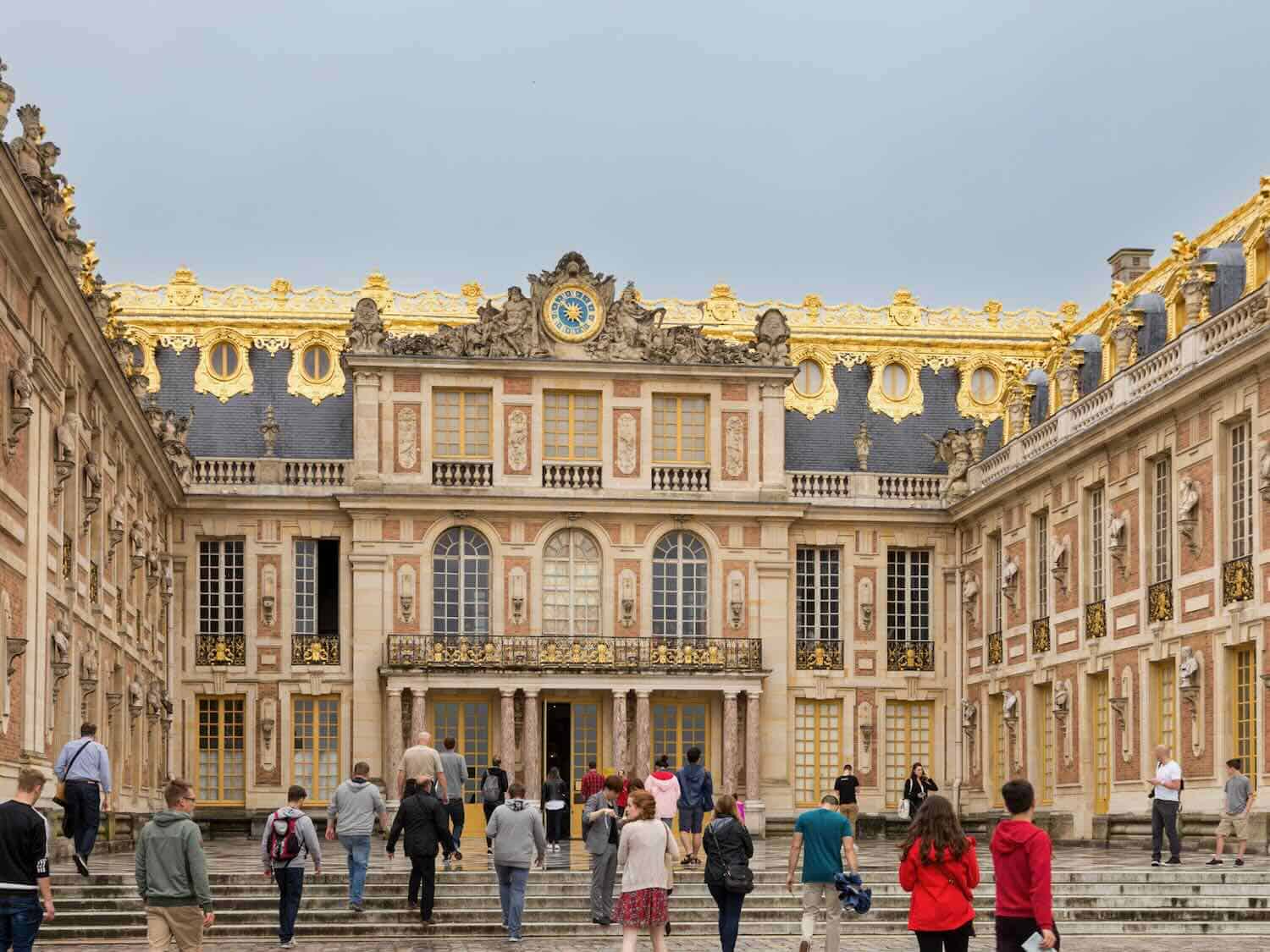
King Louis XIV thought of himself as the Sun God, divinely chosen by God to be King. He transformed and expanded his father’s old hunting lodge deep within a forest. The hunting lodge laid the basis of the Château de Versailles we know today.
The King hired the team of Louis le Vau (an aristocratic architect), André le Nôtre (landscape designer), and Charles le Brun (fashionable interior decorator and painter), to create the masterplan.
The entire building project, including the expansive and expensive formal gardens, took 21 years and consumed billions of the French treasury. Louis XIV spared no expense and didn’t incur any personal debts. He used state funds to build the complex.
The latest research I could find (from HistoryExtra.com) says, “As of 2016, due to a lack of data and historical currency conversion being arcane at the best of times, calculating the cost is tricky. In 1994, American TV company PBS concluded that the French Palace could have cost anywhere between $2-300 billion in today’s money.”
Boomer Travel Tip
MedjetAssist Members who are hospitalized 150 miles from home receive medical transport to a home-country hospital of choice. Memberships from $99.
Louis XIV wanted total control, so he moved his Court and government to Versailles in 1682, making it the center of what he called “beauty and power.” Approximately 10,000 people lived and worked on the site, but few experienced the comforts like the King.
After Louis XIV died at age 76, the two succeeding kings continued embellishing the Palace until 1789, when Louis XVI and Marie Antoinette left during the Revolution. (Your visit will give you a better understanding of why the people revolted.)
Accounts differ, but the official website claims,” Versailles is capable of holding up to 20,000 people, has 700 rooms, more than 2,000 windows, 1,250 chimneys, and 67 staircases.
After the French Revolution, the Palace never again acted as a royal residence, but the site became the Museum of the History of France in 1837. King Louis-Philippe (1830-1848) saved the structure by using it to house collections of French paintings and sculptures. These collections continued to expand until the early 20th century, when the eminent curator, Pierre de Nolhac, returned the Palace to its appearance as a royal residence during its heyday.
What to see at Versailles
A visit begins at the golden gates of Versailles, and your entry depends on the type of ticket purchased. Before your arrival, buy a timed-entry ticket or book one of the many guided tours offered online (find them here).
You can download the free audio guide app (get it here) or pay to take a docent-guided tour. Guided tours often mean less time waiting in long lines and offer the best way to see Versailles.
Best things to see in the Palace
The interior rooms of the Palace of Versailles overwhelm the eye. They look gloriously gaudy but are an exceptional glimpse at the past and a real treasure for France. Pay special attention in the King’s bedchamber, the Hall of Mirrors, the Royal Chapel, and the Queen’s apartments, Versailles’ most famous rooms.
The King’s Bedchamber
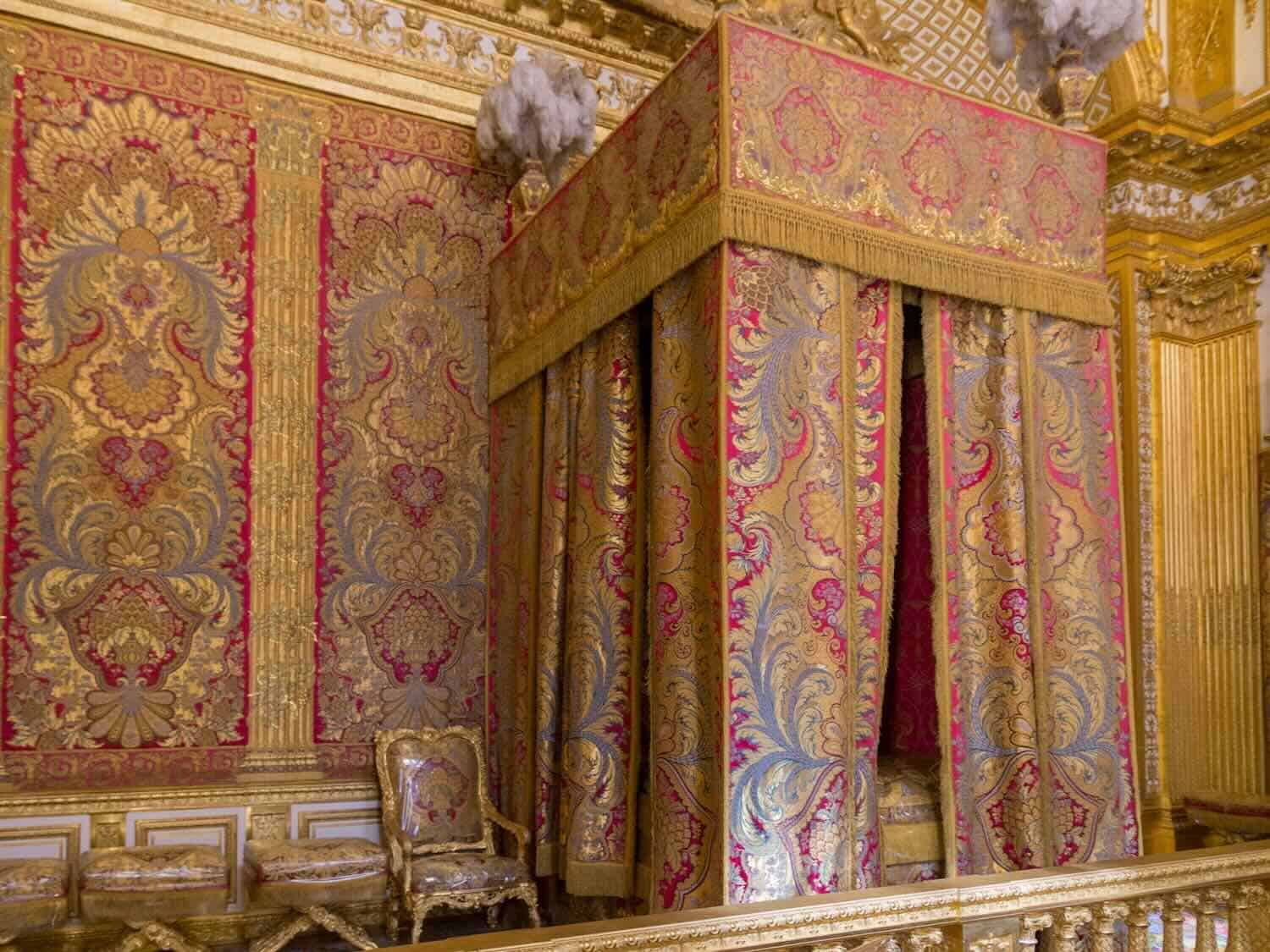
From the exterior, the Kings Bedchamber lies under the central clock and the three windows of the main façade. Naturally, it gets the morning sun- for the Sun King.
The furniture and décor practically drip in gold. The center of the bed appears voluminously draped, and white ostrich feathers adorn the top, a luxury reserved only for the royal couple.
Being invited to be present during a waking or retiring ceremony in the King’s bedchambers was considered a privilege and the cause for rivalry in the Court. As a matter of respect, the Queen could not enter the King’s bedchambers. The King would visit her in the adjoining apartments.
When Louis XIV reigned, the Court would fight to observe and follow his daily routine from arising in the ceremonial canopied bed (not his actual sleeping room). He and the Court attended mass daily.
Louis loved showing off his beautiful gardens; you will later see why.

Look for a copy of the most famous portrait of Louis XIV over the fireplace. The painter, Hyacinthe Rigaud, created the original in 1701 upon a personal request by the King, who wanted to give it to his grandson, who had recently become King of Spain.
So pleased with the result, Louis XIV decided to keep the original for himself and commissioned copies from the artist. A 1702 copy is seen in Versailles, while the original painting hangs in the Louvre Museum.
Your visit won’t include the King’s private study, but knowing the Mona Lisa hung on the wall is fun. If you’re curious, King François I bought the Mona Lisa after Leonardo’s death and exhibited it at the Palace of Fontainebleau.
The painting remained there for over 100 years until Louis XIV took it to Versailles. After the French Revolution, the Mona Lisa moved to the Louvre.
I found it difficult to recall the differences between salons with names like the Apollo, Mars, Mercury, and Venus rooms. Even the throne room and coronation room remain buried treasure in my brain. But they are opulent and have ornately painted ceilings.
Boomer Travel Tip
In today’s travel climate, trip insurance is a must. Compare policies and rates at InsureMyTrip.
Hall of Mirrors
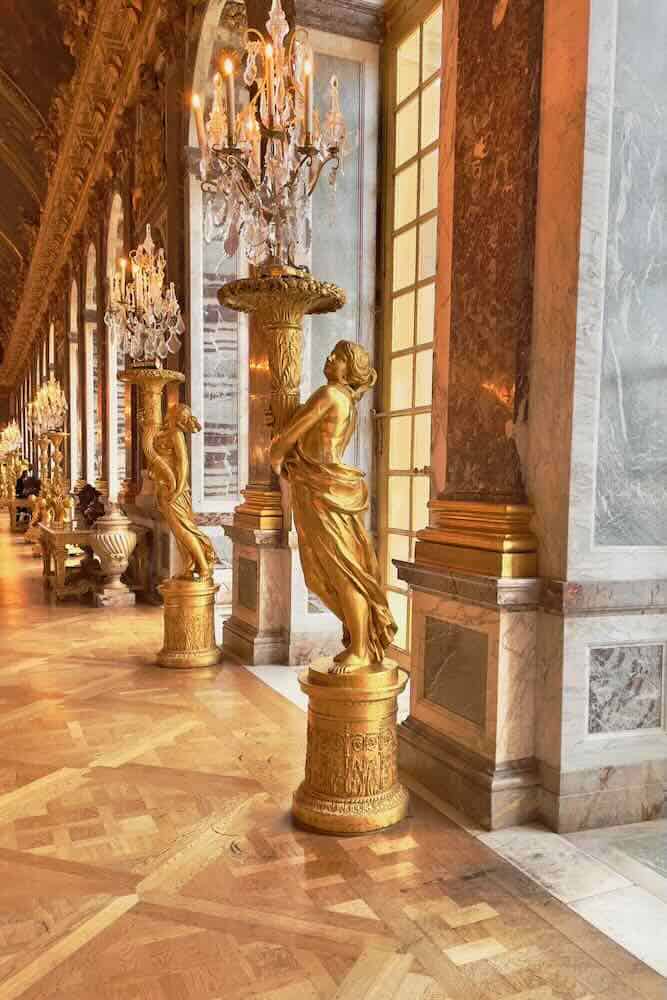
All 250 feet of the Hall of Mirrors stuns magnificently. One side features 17 arched mirrors lit by sunlight from 17 opposite arched windows overlooking the Versailles gardens. Mirrors were new at the time, so they were more than an exorbitant expense
Golden candelabras line both sides, and numerous crystal chandeliers hang from the sparkling golden ceiling. I can only imagine the hall blazing in candlelight and sprinkled with just a few elegantly costumed guests. Alas, your view will be full of tourists.
The Queens bedchambers, similar in style to the kings, and council room lies on the opposite side of the Hall of Mirrors. The Queen’s room saw the birth of 19 royal babies (including Louis XV and Louis XVII) and the death of two queens.
The Royal Chapel
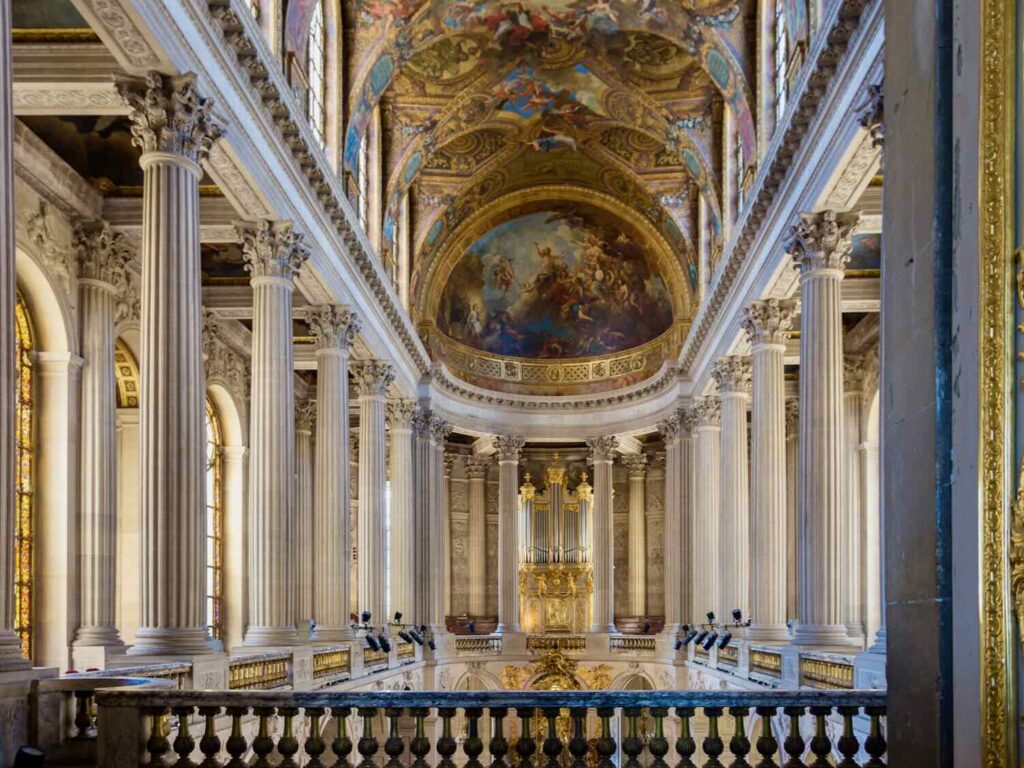
Construction of the Royal Chapel was completed in 1710 at the end of the reign of Louis XIV. The building’s Gothic design features large glass windows and buttresses.
Every day the royal court attended the King’s mass at 10 am. The sovereign sat in the royal tribune surrounded by his family. The officers and members of the public were seated in the nave.
The King never descended into the nave except during religious celebrations when he took communion, ceremonies of the Order of the Holy Spirit, and the baptisms and weddings of the Princes and Princesses.
The Royal Opera House
Inaugurated on 16 May 1770 for the wedding feast of the Dauphin and the Archduchess Marie-Antoinette, this extraordinary theatre was used only 40 or so times before the Revolution. Later use included other royal weddings, ceremonies to honor foreign sovereigns, and balls and shows.
Although the Royal Opera survived the French Revolution, all its furniture, mirrors, lighting, and décor were lost. Louis-Philippe commissioned its restoration when he created the Museum of Versailles.
At the end of the Second World War, the Royal Opera House rested nearly in ruins. The building was again restored and formally inaugurated in April 1957 in the presence of Her Majesty Queen Elizabeth II. Since 2009 the Royal Opera has hosted numerous concerts and shows.
Visiting the Gardens of Versailles

Get ready to walk your feet off in the fabulous , near 2,000-acre sprawling gardens, lined with walkways and dotted with fountains and statues. The Versailles Park and Gardens are open daily. Garden access is free except when they give fountain shows and musical garden events.
I encourage you to check the website and plan a visit when the fountains flow. You won’t be disappointed.
I did this in the summer of 2016, spending an entire day in the gardens plus touring The Estate of Trianon (a favorite of Queen Marie-Antoinette), located within the gardens. I recall walking over ten miles, according to my Fitbit, but the sense of grandeur remains unreal.
Be sure to grab a map before starting your Versailles garden tour; getting turned around is easy. The Latona Basin is one of the first grand fountains you will see, not far from the Palace exit. You can stand above it and overlook the Grand Canal and central path.
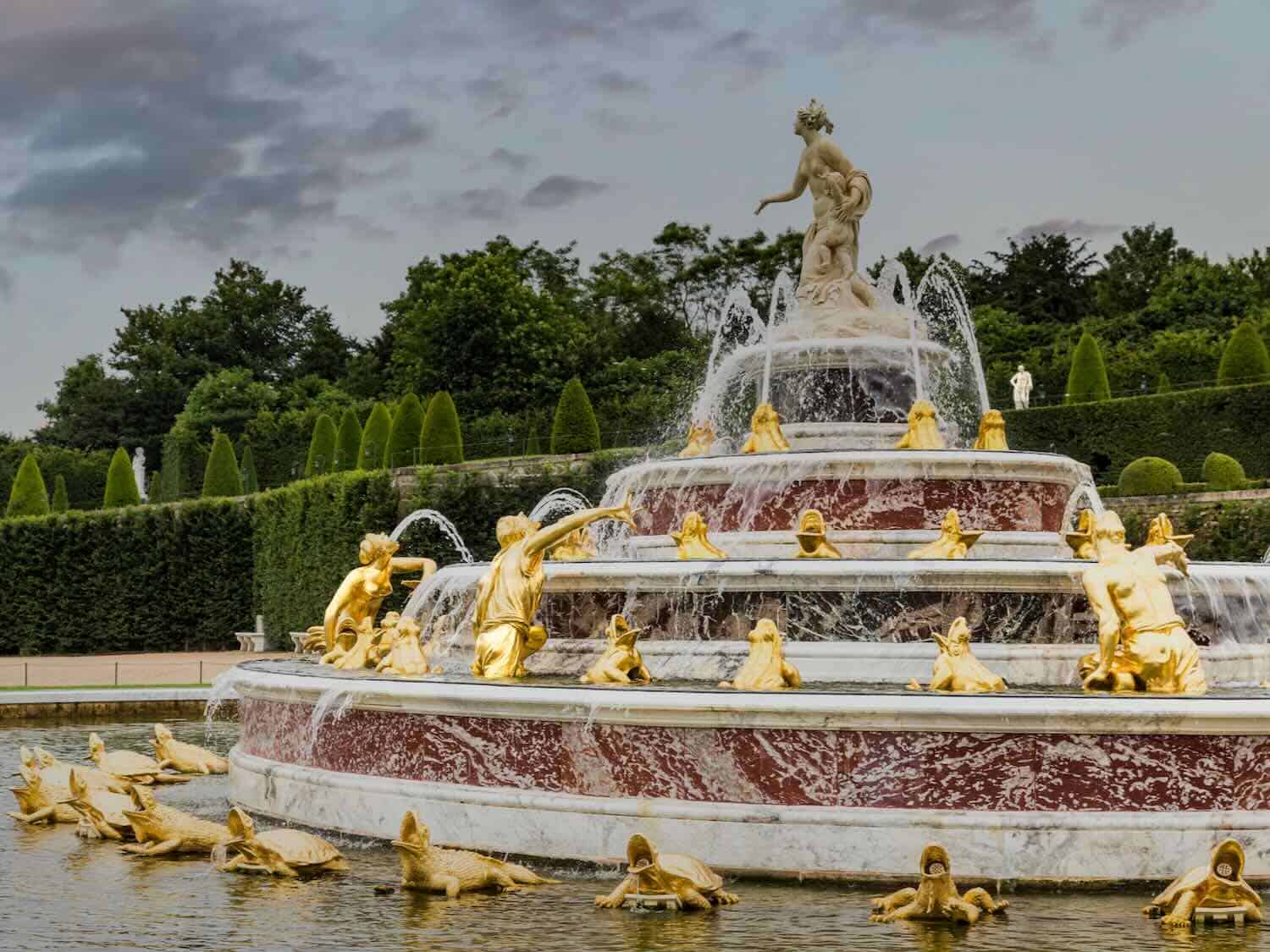
My favorite water-spewing configuration remains the Apollo Fountain. No surprise, this golden ensemble features Apollo, the Sun God, riding his chariot. (Take note, it is scheduled for renovation in 2023.)
To the left, I watched dancing waters, similar to those at the Bellagio. I suspect the Las Vegas attraction took its inspiration from Versailles.
One garden area features grottos with bubbling waters and cascading waterfalls. The central Grand Canal obviously gets its name from its namesake in Venice.
Look for the few areas to grab snacks and eat lunch, a much-needed time to sit and relax.
The Trianon Palaces
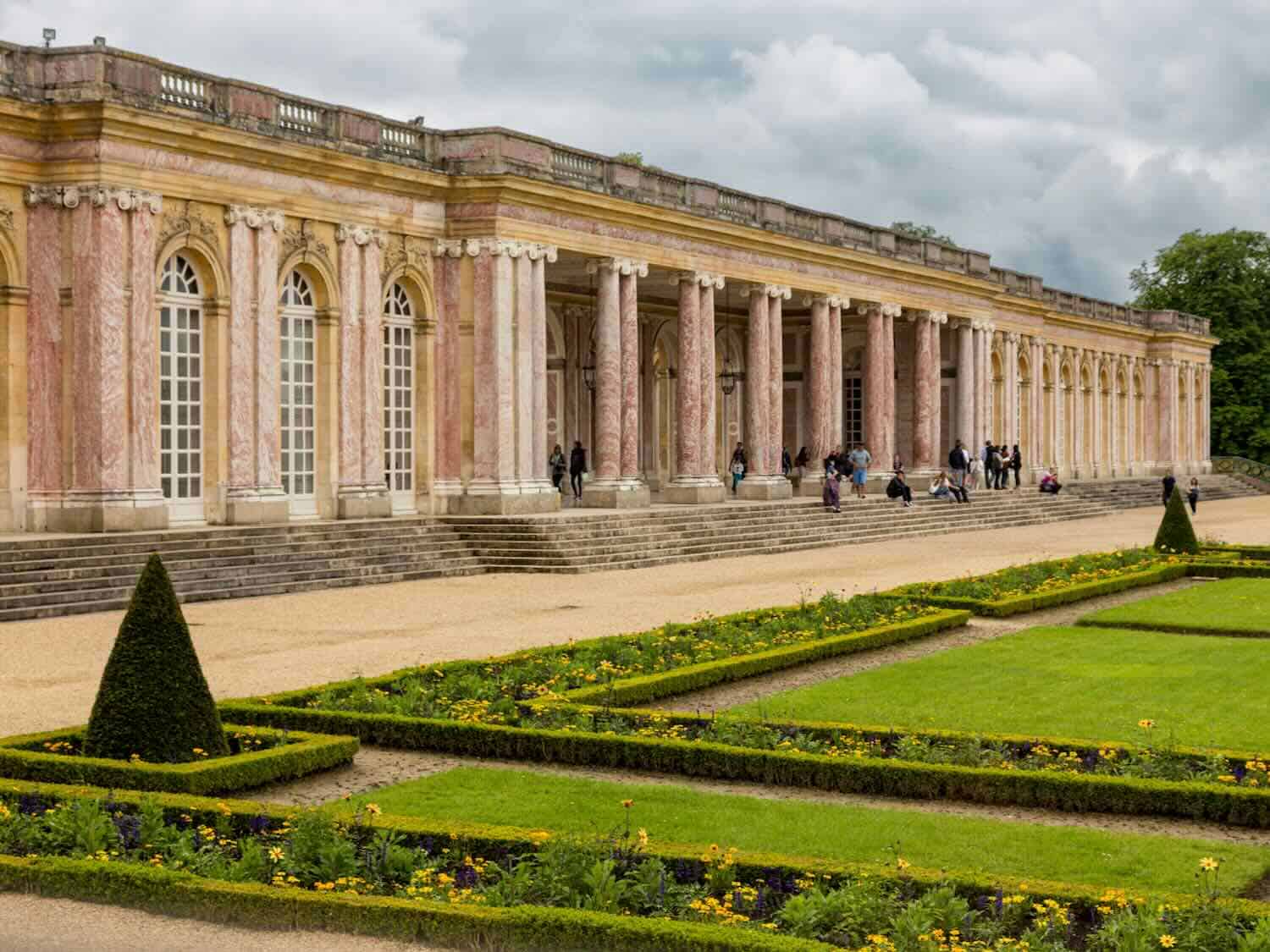
The Grand Trianon, erected in 1687 within the gardens, was commissioned by Louis XIV in 1670 to escape the dizzying hubbub of the Court. He also wanted privacy to pursue his affair with Madame de Montespan.
Influenced by Italian architecture, the refined Trianon palace is a single story flanked by a courtyard on one side and gardens on the other. A handrail runs around the flat roof. The Peristyle, a sheltered colonnade, connects the two wings of the Grand Trianon.
Immense flowerbeds and terraces showcasing thousands of aromatic flowers and orange trees surround the Trianon. The King loved the smell of flowers, and during his reign, these shrubs were then buried in the flowerbeds, allowing them to be changed daily. The result was a captivating, ever-changing floral spectacle that perfectly complemented the architecture.
Marie-Antoinette preferred the Petit Trianon, which Louis XVI gave her as a gift. She had the Queen’s Hamlet constructed between 1783 and 1786, an example of rural life.
The model village, inspired by the rustic architecture of Normandy, included a windmill and dairy, a dining room, a salon, a billiard room, and a boudoir. Although it was reserved primarily for her children, Marie-Antoinette also used the Hamlet for her guests and special events. (I did not have the energy to tour the Hamlet, which I regret, but one can only cover so much ground in one day.)
During the Revolution, the Trianon’s original furnishings were lost. Later, Napoleon commissioned a restoration and had the Trianon fully refurnished. He occasionally spent time here with the Empress.
In 1963 General de Gaulle renewed the structure and used it to host visiting foreign dignitaries while converting the North Wing into a presidential residence. It no longer functions that way.
Stay longer: The City of Versailles
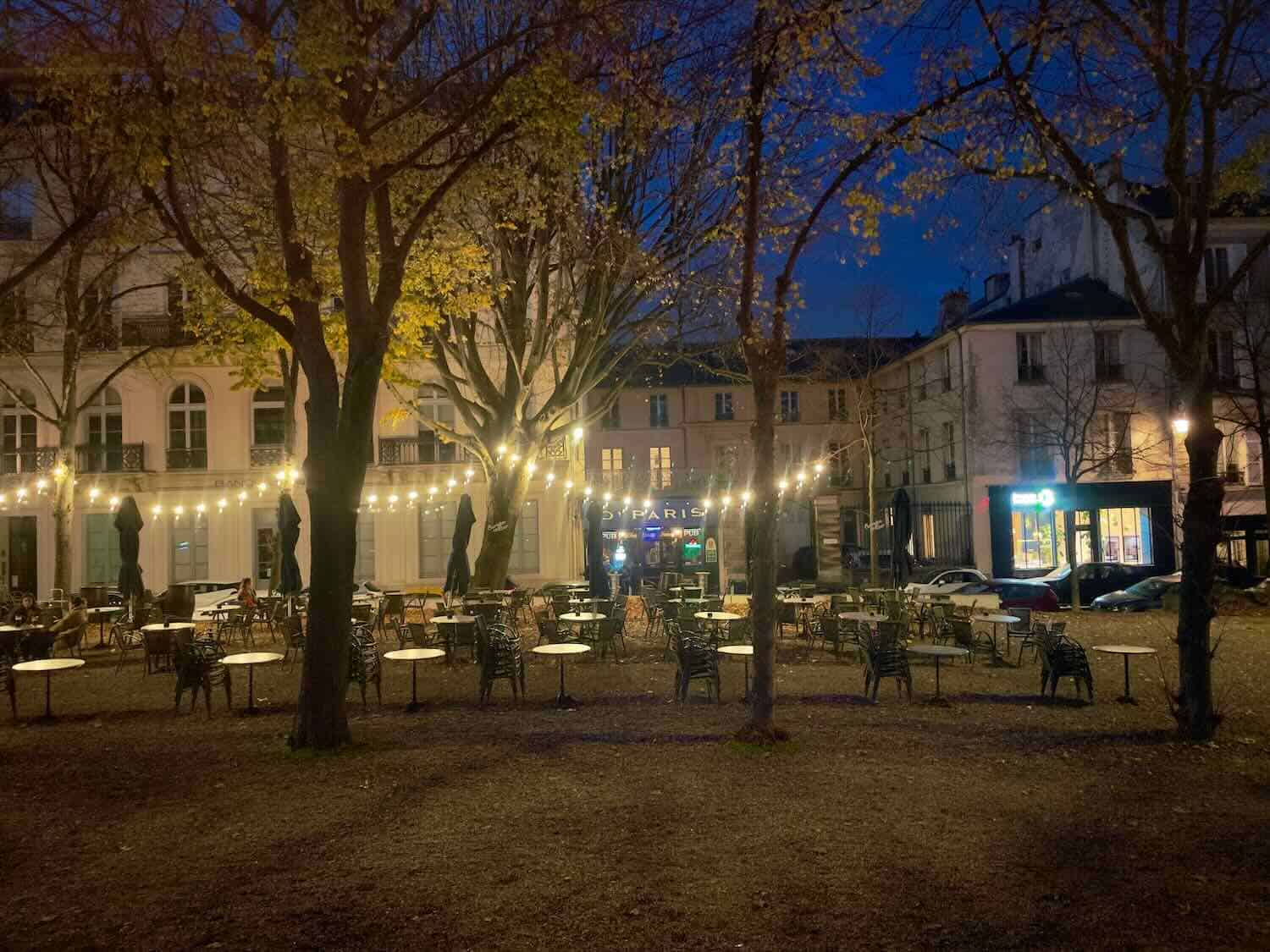
If time permits and you’re still standing, the little town of Versailles offers many restaurants and cafes.
You might consider turning your day trip from Paris into an overnight (look for lodging here). This will give you two days to tour the Gardens. Use these virtual tours to help plan your trip.
Getting to Versailles from Paris by train
The train is the easiest, quickest, just 12 minutes, and least costly route from Paris to Versailles. Get off at the Versailles Chateau train station. There are some handicap accessibilities to help visitors with disabilities

